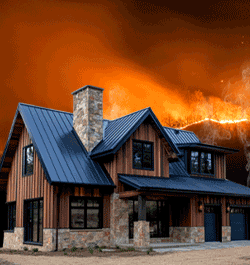Justin Ache - Ensuring Roof Longevity and Efficiency - PODCAST TRANSCRIPT
July 28, 2025 at 12:00 p.m.Editor's note: The following is the transcript of a live interview with Justin Ache from Gibraltar Building Accessories. You can read the interview below or listen to the podcast.
Intro: Welcome to this episode of Roofing Road Trips from Roofer's Coffee Shop. My name is Karen Edwards and today we are going to be talking with Justin Aki from Gibraltar Building Accessories and Airvent about lots of cool things that they have going on at their company. Justin, welcome to the podcast.
Justin Ache: Thanks for having me, Karen. I actually do listen to this podcast on my own too. So it's fun to be on one these for once.
Karen Edwards: Nice, nice, but you probably are gonna be your own worst critic.
Justin Ache: easily. Yeah, yeah. that's... Listen, I also hate the sound of my own voice, but I'm on a lot of these darn things, so it's just an ever-going battle.
Karen Edwards: Well, you've got the setup, you've got the headphones and the mic on and we'll make you sound great. Okay, so for those who might not know, first of all, just tell us a little bit about you, maybe your background, what you do there and what Gibraltar building accessories and air vent, what do you guys do?
Justin Ache: Appreciate it.
Justin Ache: Yeah, so I'm Justin Aki. I'm the division marketing specialist for Gibraltar Building Accessories. We are a group of, God, I want to say 14 companies, 19 locations. If it goes in or on your house or in your roof made out of metal or it's ventilating, we probably make it or do it. I personally support all of our sales initiatives, making sure that they have assets and content to get in front of people, to bring what we have to distributors, contractors, retailers. But yeah, I also help build some of our internal tools, our calculators, some website work. It's just, it's a never ending battle to make sure that we're out there. So that's pretty much what I do.
Karen Edwards: Yeah, you're involved in a lot of different things, Justin, for a lot of different companies as well, right? And so Justin, he's got a lot of knowledge about a lot of things. And one of those things that we want to spend a little bit of time talking about today, you mentioned ventilation, right? This is one of those subjects that it can be a little bit intimidating for contractors. you guys, through AirVent, I think you've done a fantastic job.
Justin Ache: Yep.
Karen Edwards: at providing education in a bite-sized session to contractors across the country. Maybe you could talk a little bit about that. What do you call it? The road show?
Justin Ache: So that show is actually the air event ask the expert seminars put on by Paul Chelsea He does it for three to four months at the beginning of the year You know some of a slower term for roofers does it across the country free of charge? Just to get people in there and make sure they're educated about ventilation ventilation and roofing You know some kind of ten you in education build around it But I mean that's Paul's only job is to educate I mean, I believe he's been on your podcast before to try not to step on his toes, but
Karen Edwards: That's it.
Justin Ache: You know, some of the stuff we've been doing recently, it's really been the Justin show. So just want to make sure that, you know, I could talk to any of the things we've been building about ventilation. Because I mean, it's not optional. It's essential. You can install the best shingles in the world, but if you're at it can't breathe, that roof's going to fail. So, yeah.
Karen Edwards: Right. Yeah. And, you know, a lot of contractors don't even look in the attic before installing a roof, right?
Justin Ache: Yeah, that's the biggest part about coming up with education. I mean, a lot of guys in the trades are great at shingling, great at installing roof, but never really ever touches balanced airflow. And that's not what you want to consider when you're talking about warranties, insulation, home energy efficiency. If you can't speak to those as a roofer, all you're doing is just being a shingle guy. Anyone can be a shingle guy. A professional roofing company should care about the whole house's lifespan because of the roof.
Karen Edwards: Right, because you may look at a roof and there may be what appear to be vents on there, intake, exhaust, but are they working? Are they being blocked? Is the intake being blocked by it's soffits, by insulation or something? And you don't know that unless you do take that look inside because what are some telltale signs that it's not working?
Justin Ache: Yeah or is the ventilation improper for the roof? You mentioned intake. That's a big one. You can technically never have too much intake. You can have too little exhaust. But we've seen a lot and actually Paul, if you follow him on socials, he'll post stuff called Found in the Field where you'll have three or four different types of vents on a roof right next to each other. So they're just canceling each other out. You've done nothing good for the roof and you're going to catch that. Everyone really doesn't care about. ventilation until the ice dams and curled shingles. it's, it's, yeah.
Karen Edwards: Right, right. Or you go up in the attic and things are damp or rotting or there's mold growing. You know, it can really cause harm and it affects the energy efficiency of the home as well, right?
Justin Ache: 100%. I mean, that's the other sad thing is you can have a professional roofing company completely plan for something and then the homeowner calls someone else out, like let's just say an insulation guy and completely negates all the work that's been done to properly put a roof on that house. And so you're going to see the roofer have to come out every three to four years to fix those kinds of problems. So yeah, it's about also making sure that the roofer can educate the homeowner and customer about, hey, you know, this is going to make sure your house last longer, you have energy efficiency, you're not running your AC bill in the summer. I'm in Florida, so right now my AC is actually shut off for right this second. I'm not sure why. It's probably going to storm outside. generally, it's running most of summer. it's one of those, the better you can make sure your attic is ventilated, the less it's going to pull from the inside of your house, make your AC run more, create more moisture, mold problems in the attic. It's not a good thing.
Karen Edwards: Right and not every ventilation product is gonna work on every home, right? This is not one size fits all.
Justin Ache: No, no, every roof is different. Every roof is special. mean, considerations are, you know, complex gets built with 15 of the same type of house. You you plan it once and you're good to go. But reroutes, older homes, custom homes, new homes, tile homes, they're all different enough that you need to consider the attic square footage, the attic shape as you're planning out your ventilation plan.
Karen Edwards: How do you make the decision about whether a home is a candidate for an active ventilation system or a passive? What kind of factors should be considered when determining that?
Justin Ache: Actually, I did learn this from Paul, so I can easily regurgitate it, so he'll appreciate this. Whenever possible, if available to your roofing system and it works with what you've determined to be the proper airflow, a ridge vent system is the best thing you could possibly install on your roof, because it's allowing the most air to exit evenly across the ridge of the roof. The next step down, if you're not a candidate for a ridge vent, you're probably going to be looking at a power fan, depending on your climate and where you're at.
After that, we get into the variations of static vents, the box vents, the turbines, that kind of stuff like that. And then finally, we can look at like gable vents. Again, every time you step down from that peak of where ventilate the whole attic, you're making some considerations about what you're going to exhaust. So if you go to a static vent, you're going to cut a bunch of holes in the roof. Not always the best thing when you just installed a new roof. It might be the thing which you have to install. Let me talk about like a hip roof is going to be different than just a long flat gable style roof.
Gable ends, you you're only allowing air to exit from each end of the house and not out of the roof. So you're going to limit what and the heat is going to build up in the top. And that's just a consideration you have to do when you're planning out the roof or you might be limited to what's inside.
Karen Edwards: Wow. So let's talk a little bit about figuring it out. It's not always easy, especially if it's not something you do all the time. I know I did attend. will say, shout out to Paul. I went to one of his, it's two hours, ventilation Ask the Expert seminars and he made it fun and interesting and interactive and I walked away with a lot.
But he's been doing this for a very, very long time. So it's real easy for him to talk about net free area and this and this fraction of this and my head starts to spin. how do you make, especially when it comes to math, I never really enjoyed it that much anyway, but how do you make it easy to help a contractor figure out exactly the amount of ventilation and how to find that right balance?
Justin Ache: Thanks.
Justin Ache: Well, first I want to say Paul probably appreciates here and that's a fun event. Some people just go for the free breakfast. You got to consider that too. So that's the other problem is I also struggle with math. I am a computer person. I like gadgets. I like tech, but I'm not necessarily doing long division for fun in my dining room. So when you consider what is truly necessary for a roof, you're trying to figure out the exact square footage of a house. Now, roofers have a little bit easier because they know approximately like shingle roofs. A lot of those guys work in squares, hundred foot sections. They know approximately.
Karen Edwards: You
Justin Ache: Base, you can just walk around the house and measure, but you're trying to figure out the square footage of the attic. And then with a little bit of math, that's gonna let you determine how much you need to exit for the exhaust. Now, I'm gonna get into the calculator talk a little bit later on, but generally, the steeper the roof, the more volume you have, you're gonna need to exhaust more air, but overall, you're trying to determine how big the roof is. I mean, that's why you're quoting a job anyway, so it's not taking too much from there. But...
We have made it little easier as far as determining the NFA required for your attic based on code, based on best practices, based on what the manufacturers, shingle manufacturers and ventilation manufacturers want to do. So when you're planning out your roofing plan, you take, I'm just going to suggest our calculator that we're going to talk about, to determine how much NFA you're required to get intake and exhaust. Because you could put as many vents on the roof as you want for exhaust, but that's not the best thing. You also need to balance it with proper intake.
Yeah, you're going to want to if you've done Paul's class, he does have two great slides on how to do back of the napkin math, but I'm not a roofer. I'm not out there every single day. Or I'm not a distributor at a counter trying to figure out what I'm supposed to sell a contractor. Or I'm not in a retail store trying to explain to a homeowner what they should ask their roofer to buy or what they're looking at planning from. Because mean, homeowners 90 % of the time they're going for how much is going to cost me what it's going to look like. They're not thinking about that. That end result. Like, what's it going to do for my roof? And the whole point of our education. the seminars, our website, our interactivity on social media, working with Rupert's Coffee Shop, our page there is to educate that, you're going to need good ventilation, intake and exhaust.
Karen Edwards: Yeah and you know, this is for, I mean, we're talking homes and attics, but I mean, think about other buildings that, like a church, right, that maybe has pitched roofs, you know and I'm not sure how many, what kind of products you have that are applicable for commercial, but you know, there's considerations there, I'm sure.
Justin Ache: Funny enough, just re-roofed, like I was able to get a drone video of a roof install in Jacksonville of a church. And again, that was two weird peaks and just the spacing so weird, but you have to plan for that as you're doing your ventilation. And it's also two stories off the ground, it's a big thing. That roofer was very professional and they tied off. was fun to see. But yeah, as far as planning ventilation, every building is different. And commercial applications, there are some limited, we mostly focus... on the residential market. People have used some of our products in the commercial space. You're really gonna look at what is applicable for your situation. Don't try to use one of our vents, for example, like a smoke hood out of a kitchen. You're gonna wanna get something else in there like an HVAC contractor. But yeah, as far as roofing's concerned, flat roof, stuff like that, we have some applications, but yeah, we're really focused on the residential market and educating the residential roofer on the proper way to balance your
Karen Edwards: Right. Education is so important when it comes to ventilation. I'm curious, because you mentioned to code, figuring out things to code. And I know codes vary based on where you are in the country. Obviously, Florida's got some of the toughest. California's got different codes. Does it fluctuate from region to region for ventilation?
Justin Ache: So for code, as far as the products themselves, it will. Your product that you can install in certain locations is going to be limited if you're under a certain code body, let's just say Miami-Dade or you're trying to be Florida Building Code approved or I believe Texas has the TDI, Texas Department of Insurance. So that's going to vary as far as what you can install. But overall, the planning for your ventilation follows a ratio and I believe the code nationally is 300 to one on the exhaust, like to make sure it gets out.
But we recommend, Aerovent recommends and even shingle manufacturers recommend a 150 to one because it's going to ventilate your attic even better and it's going to extend the life of your roof. I mean, yeah, it's planning for the location. You're limited by what you can get, what's available to be installed. And then again, you're going to have to plan around the properly venting your attic.
Karen Edwards: Right, right. So you mentioned shingle manufacturers. I'm curious what changes, if you change that, if you're not using shingles, say you're gonna do tile or metal or a synthetic composite type material, does that vary the requirements or change what you ought to be thinking about in terms of ventilation?
Justin Ache: Well, a roof is a roof is a roof. You still need to ventilate. All that's going to change by the type of roof you're installing is the type of product that's going be available to you. We do have offerings in tile. We do have offerings in metal. It's going to vary, but you're still going to want to make sure that it's properly ventilated. So I mean, you're not getting around code just because you installed a weird roof.
Karen Edwards: No, you're not. And you know, it really when we talk about a roof being a system, right, it's more than just the shingle. It's more than just the metal. It's the underlayment. It's the drip edge if you need it. It's, you know, all those parts and pieces. And we always seem to leave out ventilation.
Justin Ache: Unfortunately, I mean, that's part of our goal is to properly educate the, let's just say the up and coming roofer. Cause I mean, the roofers who have always been doing this, I'm not going to downplay what, know, I've always done it this way, but you know, stuff changes, technology changes, what you can get changes, what they've installed 25 years ago might not be available today or it's gotten better. And they're not planning that when they're making their roof plans. I mean, we want to make it easier for the roofer to educate the homeowner to build clean code compliant system.
I mean, it's really about bringing that skill gap from the younger roofers to be confident when they talk about ventilation. It shouldn't be the part of the job you cross your fingers on or you're like after thinking about it. And again, it's getting in front of the distributors. It's getting in front of people who are going to talk to the roofers because I'm not in the field every day. Paul is not in the field every day. We do have teams talking to roofers every single day, but they're not talking to every roofer every single day. So you've got to get in front of anyone who will talk to a roofer.
Karen Edwards: So talk to me about some of the places where people can go to find this information. Do you have videos on your website? Where do I find the calculator? If I'm listening to this and like, wow, these tools would be really helpful for me or I want to watch a presentation, where can I go?
Justin Ache: Well, I mean, we have a lot available, let's just say on the air vent side. So if you go to airvent.com, that's going to take you to our main website for our ventilation products. We have a whole product line of ventilation for products for your area. We do consider what is available for regionality and contractor choice. Again, there's so many decisions made in different states because sometimes it's always really it's been done. Sometimes that's all what's available. Sometimes there's material changes that people just prefer. But if you go to airvent.com,
That's going to bring you to what we sell. And I'm going to admit, we're a company, we sell ventilation. it's self-servicing, I'm going send you there. But on that page, right at the very top, it's going to be something called the ventilation calculator. And you go there and you input the square feet of your attic. Easily measurable, like I said, you can walk around your house, you can do it by the amount of squares, you can just kind of figure out generally. And then you plug in that in, it'll tell you what is required to meet that standard for ventilation. Now, if you want to go further and learn a little bit more about ventilation overall,
Paul Chelsea has videos on YouTube on our website. have a whole ask the expert section on there. We've called it Aervitt University. I believe the dropdown says Aervitt University. Click there. We have videos. have monthly education sessions, including quizzes. You can win prizes and stuff. We have videos you can follow along. have not just listening plans. the word I was thinking about we just talked about the other day, but we have a lot of resources for contractors to have. in their hands when they're talking to homeowners or just to teach their crews and teach what they're working on. I mean, going out to the calculator, if you go to airvent.com, go on your phone. And the reason I say go on your phone, go on the website if you want to, but go on your phone because it's mobile friendly. And when you're standing around talking and figuring out your budgeting, figuring out your concerns, when you're gonna give a quote to a homeowner, you can already start planning for, I know approximately the cost of a box vent in my area. I know I'm gonna need for this roof, this many box vents. Maybe I need to plan around that. or I need to plan for a Ridge Venn or what's a good candidate for this house. So our calculator is mobile friendly. It's easy to use in the field. We really want to make sure that the contractor has access to it. The distributor has access to it. Heck, the homeowner, if they really want to know like, if they count on their roof and they see two holes in their roof and they're like, what's up with those? What do I need to do here? So yeah, that's the big thing is the calculator is accessible on airvenn.com or if you wanted to go to Gibraltarbuildingproducts.com.
Karen Edwards: You
Justin Ache: and click through to our ventilation section. But I'm gonna make easier on your listeners. Also, you can go through Rufus Coffee Shop. We do have a listing there. It's under Gibraltar Building Accessories, Gibraltar Building Products. Scroll on down, we have all of our availability for roofing accessories, metal, flashing, strip edges, fun stuff like that. yeah, I'm on here today to talk about ventilation, because it's a passion of us, so.
Karen Edwards: That's right.
Karen Edwards: Yeah. Yeah. And you know, if you do attend any industry trade shows, I just saw Justin at the Florida show. He has a great smokehouse that really demonstrates and visit visually tells the story of how the air moves in the attic. And I would highly recommend you look them up in the directory and swing by the booth to see that in action, because it's pretty cool.
Justin Ache: Yeah, I'd love to do that demo in person live. Paul has videos of that same smokehouse demonstration, even a bigger house. We have testing with actual like smoke sticks, not just my little fog machine. yeah, Florida was the FRSA we just had. You got to see you and say hi to the whole team there. The next show I know I'll be at probably with the smokehouse will be the Western Roofing Expo. I believe that's late September. But again, our website has video links. Our YouTube has videos to better educate people. I believe actually.
Karen Edwards: Yeah.
Justin Ache: Brewers Coffee Shop, your YouTube has a couple of our demos on there too, so can see me at one of the shows doing it.
Karen Edwards: Yeah. Yeah, I know. Yeah, we always we do a lot of video at the show. So if you can't make it, we want you to see what's happening. And I know we've done the smokehouse. I just couldn't tell you what show.
Justin Ache: God, no, it's probably every other show because one of your producers wants to get in there and get a full demo. I have no problem doing that demo multiple times. I've done it a couple hundred times now.
Karen Edwards: Yep. Yeah, yeah. And I tell you what, the folks on the AirVent team and at Joe Braultor, they have incredible energy. If you can't tell from Justin, he is passionate about what he does. He's got a lot of energy and is excited about it, just as Paul is. So it's just great to spend time with that team and to talk with him and learn at the same time. So it's like a double bonus there.
Justin Ache: Well, thank you for that. mean, keep in mind, you're a Rufus coffee shop. I am on a lot of caffeine right now because of coffee. So that's why I have the energy. I think Paul's naturally that way, but I have to have to adjunct with coffee.
Karen Edwards: That's awesome. Well, I love what you guys are doing for the industry. If you need to know anything about ventilation and you want to learn more, like Justin said, airvent.com has the tools. They've got videos on YouTube. They have a directory on roverscoffeeshop.com. So you can get all kinds of information. You can get links to their website, find them there. And it was great to have you here, Justin, to talk about ventilation. Such an important topic.
Justin Ache: No, I appreciate being here. And if there's anything I help your team, Roofers, Roofers Coffee Shop at large, I'd be happy to please reach out to me. You can find my contact information on our website.
Outro: Yeah, awesome. And I want to thank everybody out there for listening today. Be sure to subscribe on your favorite podcast platform. Follow us on social media as well because we don't want you to miss a thing and we hope to see you on a future episode. See you next time. Bye.























Comments
Leave a Reply
Have an account? Login to leave a comment!
Sign In